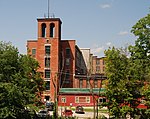Napoleon LaRochelle Two-Family House
Houses completed in 1890Houses in Southbridge, MassachusettsHouses on the National Register of Historic Places in Worcester County, MassachusettsNational Register of Historic Places in Southbridge, MassachusettsWorcester County, Massachusetts Registered Historic Place stubs

The Napoleon LaRochelle Two-Family House is a historic house at 30 Pine Street in Southbridge, Massachusetts. An excellent example of a vernacular Victorian duplex, it was probably built around 1890 for Napoleon LaRochelle, a polisher for the American Optical Company. He owned this and another house next door which was built in the same style. Its plan is a typical front-gable side entry layout, this time with a central cross gable. It has some bargeboard decoration on the front gable, and its front porch features a basket-weave railing.It was built in 1890 and added to the National Register of Historic Places in 1989.
Excerpt from the Wikipedia article Napoleon LaRochelle Two-Family House (License: CC BY-SA 3.0, Authors, Images).Napoleon LaRochelle Two-Family House
West Street,
Geographical coordinates (GPS) Address Phone number Website Nearby Places Show on map
Geographical coordinates (GPS)
| Latitude | Longitude |
|---|---|
| N 42.080833333333 ° | E -72.05 ° |
Address
West Street School
West Street 156
01550
Massachusetts, United States
Open on Google Maps











